|
|
Select
Aquatics Of Erie, CO. |
|
|
|
|
|
|
|
|
|
|
|
|
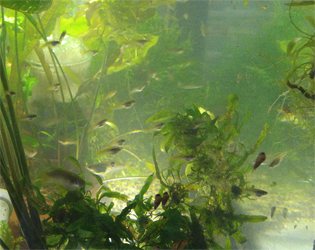 |
|
Cloudy water is common, unsightly, and will lead to greater
problems if not addressed quickly. It is nearly always
caused
by excess deteriorating organic matter in the
tank, more
than the aquarium's nitrifying bacteria, your
filtration, and
the water change schedule can process. A 50% water
change
begins the recovery, then cleaning the substrate and
filter
medium, while possibly boosting the aeration should
keep it
from re-occurring. |
 |
|
|
|
Water Quality
The
aquarium is slightly cloudy- Cloudiness in a tank is
a firm signal something is going on, and whatever it is needs to
be dealt with right away. Experience is that
cloudy water issues, triggered for whatever reason, will cause
loss of fish starting in
a few days, as conditions cause them to become vulnerable to
lower oxygenation, opportunistic
infections and other issues.
Cloudy water is simply the result of an
overpopulation of bacteria – a “bloom”, usually caused by excess
organic material in the tank.
The problem is that all this bacteria uses oxygen
as well, and the oxygen level in the tank will fall
during a bloom. Those species with
higher metabolisms, such as tetras and
barbs, will have problems most quickly. Lowering the
temperature to raise
the oxygen level
may seem like a solution, but in fact by doing so you are
lowering the fish’s metabolism, and possibly lowering
their immune system’s
ability to fight
infection, at a
time when they are most vulnerable.
So with a cloudy tank, the first thing to do is
a 30-50% water change to get them back into healthy water
before fixing whatever it was
that caused the water to cloud up. Removal
of any mulm or detritus and cleaning any filter
mediums (especially sponge filters,
as they
will hold on to decaying organic matter.) Follow with a thorough siphon cleaning of the
substrate, and reduce any excess substrate if
possible.
Using
live plants also helps maintain
water
quality. Consider what caused more organic matter to collect
in the tank than the
nitrifying bacteria and
filtration were able to keep
under control. Possibly make changes to your
feedings and
maintenance
schedule,
or boosting the filtration or aeration.
If you are
keeping bare bottomed aquariums, a sprinkling of a single layer
of 1/4" pea gravel over 1/3 - 1/2 of the tank bottom will clear
up minor water cloudiness in 3-4 days, and help
protect against future cloudiness through the addition of
nitrifying bacteria. Increasing
the aeration, possibly with the addition of live
plants will also have a positive
effect.
*** Doing a water change – The best water
to use for a water change, particularly with a tank where the
fish may already be weakened,
is to add already aged, clean water from another
healthy tank. Straight tap water can be used, properly dechlorinated with a dechlor
product, but with some fish (such as some of the
Synodontis catfish) adding fresh tap water is actually
irritating to them, and not the best
choice if you are looking to get them healthy as quickly as possible. Water changes when
raising new fry, for
example, are always best
using
clean water from
another aged aquarium. |
 |
|
|
| |
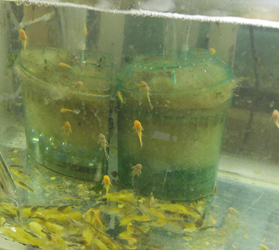 |
|
This
is what yellow water looks like, complete with a line
of foam at the water line. If your tank ever looks like
this your fish are in very dirty water that needs to be
addressed immediately. In this case, these baby
Green Dragon
Plecos were given
a few too many beans the day before, and
this is what the tank looked like the next morning. For
them,
this isn't a problem, aeration is very strong in this
tank,
and a 50% water change
and change of filter floss had the
tank back in good shape in a few minutes. |
 |
|
|
|
The aquarium water is clear, but yellowish
– This indicates an overload of organic waste, and indicates
that a water
change of at least 50% is necessary. Those
aquarists feeding zucchini,
green beans or other vegetables will
occasionally see this,
and yellow water can be created
through overfeeding or simple lack of consistent
water changes.
Though not always an immediate
problem, yellow water
indicates a deterioration of water quality
and is definitely the first step toward issues arising from a
decrease
in the
overall health of the fish. If also seen with small amounts of
foam at the water line, an immediate water change is required.
Water can turn yellow if water changes or filtration become inconsistent
or ineffective, and this is considered a fairly serious
condition for a tank.
The aquarium is
clear, but brownish – This can be caused by a number
of factors, some that are harmless or even desired,
and some that are to be avoided. Brown water is
most often caused by tannins introduced to the tank by using
oak leaves, almond
leaves, driftwood or any number of dried
plant parts that soften or lower the pH of the water. Brown
water from those causes is not
usually a problem, and is often desired, even
essential for breeding certain
types of
fish.
Or it could be caused by excess organic matter, beyond what
would cause water to become yellowish- excess fecal matter and
mulm
in particular are a problem. Some claim that “mulm is
inert”, and is harmless in an aquarium. Only in an aquarium with
very heavy water
changes, where the mulm is
older and well broken down, would the decaying organic matter
not be a problem. Otherwise, mulm is
always a problem, reducing
breeding and causing a
deterioration of
water quality.
The aquarium is
clear, but the water smells- This often points to the
need for more aeration in the
aquarium, to boost
the health of the bacteria in the tank, and for
more air exchange to assist the off-gassing of the minor odors
that can accumulate.
A healthy tank
will not smell. After boosting the aeration, then search and
clean the tank of any areas where dirt or mulm may have
accumulated.
Historically, many have used activated charcoal in filters
to ward off what they thought would be a smelly aquarium
if they did not use it. In my experience,
charcoal will clog and become ineffective fairly quickly. With
today's awareness of the need
for regular
water changes and an
overall cleaner approach
when setting up initially, I do not feel that the use of
charcoal is essential.
There is foam
at the surface of the water- When there is foam at
the edges of the water line in your aquarium, there is an
excess of organic matter
in the tank, best controlled this through
water changes to avoid
running into issues that come about from
deteriorating
water quality. This is easy to ignore if the water appears
fairly clear otherwise, but a healthy tank should not have a
layer of foam on its surface. Some
medications
available to treat common fish ailments may cause foam to build
up at the water line,
but it is temporary.
As a rule, foam comes about as a result of certain foods
that break down in a way that causes foam to develop
Beans used here do
this routinely. It is still something that needs to be resolved,
as it represents excess organic material you do not
want in your tank, and there is less "room'
for organics to accumulate, before a bacterial bloom may begin.
|
 |
|
|
| |
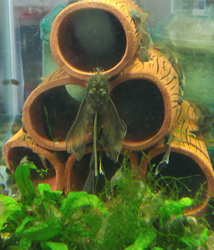 |
|
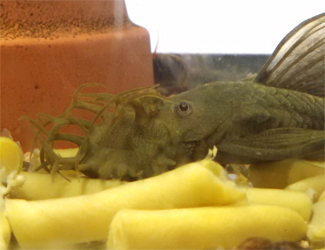 |
Filtration needs to be
increased as items are
added to the tank, that can collect mulm and
waste, and some foods, though good for the
fish, can quickly destroy the
water quality
of a tank. Here, a Longfin Green Dragon hangs
on a cave structure, while a young male feeds
on green beans. Declining water quality may
be noticed by die offs of other fauna in the
aquarium. Contrary to what some believe,
plants require clean, moving, aerated water,
just like the fish do. |
 |
|
|
|
The plants are dying- Not all
plants will survive in all aquariums. Many
plants require that close attention be paid to one or
more aspects of their
care, and without that attention, they do not survive. Often
water quality from your tap could be the problem,
as plants
generally prefer softer water. Adding salt to tanks will kill
many plants, though some, such as Java fern and
Java moss,
can be fairly salt tolerant. Many plants have a
temperature range
they do best in, and an overhead light with the equivalent of a
“Daylight” spectrum will do best for plants. Use of some types
of LEDs can also be a problem for maintaining plants.
Lastly, plants prefer water that is
regularly
changed just as you would for the fish, and many
plants must
have some water
movement in the tank. (Bolbitis fern). The
belief that fish food, or worse, an overabundance of fish food, is
good for plants is
simply not true. When caring for a planted tank, be sure to fertilize with an
appropriate fertilizer, to provide the proper
nutrition for your plants.
Here, consistently high water quality with simple CFL60 Daylight
bulbs and the Rapid Grow
Aquarium Plant
Fertilizer maintains lush, abundant plants, primarily
Java Fern, Amazon swords and Bolbitis fern.
We do not use CO2 or soil substrate of any kind,
with the exception of pure Canadian Peat for the potted swords.
The snails are dying-
I am referring to the nuisance snails we all get in our tanks,
that though unsightly, are still living
indicators of how well the tank is doing – if the
snails are healthy, the basics
are going right. When snails die there may be
a problem. A metal may have been introduced to
the tank they cannot tolerate – In the 60s people would drop a
penny
into a tank, and the copper would kill the
snails. We would never do that today, as too much copper is
toxic to fish as well.
Or the water is too soft, or the
temperature has become
too warm. Each of these issues could be a problem for certain
types of fish. If you are seeing a die off of
snails or shrimp in your tank, check the basics - temperature,
aeration, clean
the filter medium, etc., then do at least a
20% water change. Then, be
sure to remove any dead snails or shrimp from
the tank. |
 |
|
|
| |
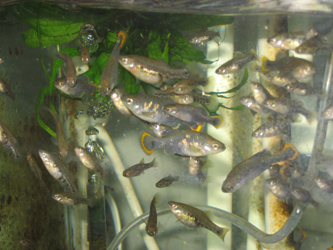 |
|
This is a Z. tequila tank with
brown algea over the front
and sides. Algea-eating
Sucker mouth catfish,
shrimp and
other life we put into our aquariums often may not eat
types of algea we see routinely. With brown algea like
this I will go in and wipe down the sides, then
boost
the filtration for a
period to clean the algea released
into the water. I will then do that procedure as I
notice
it. That has kept it in check. |
 |
|
|
|
Algea
The aquarium is
clear, but greenish- This could be the first step
toward a bout of “Green water” where a type of
algea
suspended in the water has begun to take hold.
Ignoring this could result in the tank becoming dark green in a
day or two. This is
generally not a problem for the fish, but is
unsightly, and if not addressed will spread throughout your
tanks, becoming difficult
to eradicate. Before algeacides were commonly
available, aquarists would cover the tank for a few days so that
it stayed dark,
which if done for a long enough period would
solve the problem. Today algeacides for Green water are
available at any pet store,
and most work very well. During the time that the
green water is present, it can be spread easily on nets or your
hands, creating
more tanks with the issue. After being resolved,
consider the placement of the tank, and whether it is exposed to
excess natural
light, which can cause bouts of Green Water to
return. It is a pain once you get it, but it can be eradicated
and then controlled.
The tank glass is getting covered with
green algea-
Algea will grow in any tank given the proper conditions, and a
tank can also be kept clear of algea when the
causes of the algal growth are addressed. It is caused by
an overabundance of
organic material that can
be converted into food, combined with light. This is not to be
confused with the water borne algea that
can turn your water green. These are two
different algeas, and causing the water to become green when
cleaning the common
type of algea that grows on the glass will not
cause "green water" mentioned above to start in a tank.
Algea
is a plant that can be out competed. Place the aquarium where
the amount of light
received can be controlled, and
introduce hardy, fast growing plants
that will do well in your water. When kept fairly clean with
regular water changes, even with
the use of a plant fertilizer, your algea problem should disappear. With less aggressive plants and
an environment more
conducive to algea growth, live plants and clean
conditions should keep your algea growth in check, and the
addition of a smaller
sucker mouth catfish (such as the
Green Dragon), a
catfish that eats algea its entire life, will keep it
controlled. But with the catfish,
additional feeding of
blanched zucchini or
green
beans is required, as algea alone will not keep them going.
If you do not have live plants, or they will not
work in your setup, controlling the
light, having a
pleco or
two, and keeping the tank
clean of the
algea by scrubbing occasionally may be your
best means of controlling it. Lastly, some algea types can only
be
controlled by removing it, such as the hair
algeas that some fish will not eat. With those, there isn't much
that can be done
but to clean it by hand and look into removing
the excess organic matter that is causing the algea to appear.
The tank has blue green
algea-
“Blue green algea” is not an algea, but a bacteria, and can be
tricky to get rid of. It is easily
identified by its deep turquoise color and
strong, oddly sweet smell. Some will add an antibiotic specific
for it, which will get rid of it,
but that is expensive, and often not a permanent
solution. Short of Bleaching a tank (mentioned below), when it
has occurred here
we simply wipe the tank down, removing as much of
it as possible, and we have been able to eliminate it without
bleaching or
removing the fish. Often it is the result of deteriorating
conditions, and the combination of cleaning the tank and keeping
an eye on
it, quickly removing any when it would re-occur
eventually cleared it up.
|
 |
|
|
| |
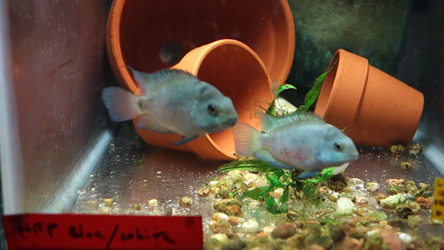 |
These are
an all blue cichlid being developed here. They are
a long way from their final form, and this is just one
of many
pairs. These are all nearly pure blue mutations, and
the young
being produced from these crosses are shown on The
Fixit Fish
page. These are 2-4 years away from being sold. With
pots that
can harbor organic waste, creating a tank where ammonia
levels
can be inconsistent, and with new fry around, the tanks
are kept
as clean as possible with a layer of 1/4 inch pea
gravel over
1/3 - 1/2 of the tank bottom. This maintains
excellent water
quality in combination with appropriate
filtration. |
 |
|
|
|
The Aquarium
Should a tank be covered?-
Whether a tank should be covered is not
entirely a cosmetic decision. Experience has shown
that with a few of the species kept here (The
Skiffias), they require
exposure to maximum air exchange at the water surface of their
aquarium. The hardier species offered in the
commercial pet trade can be covered routinely, and of course,
those prone to
jumping must be covered. However, if a species is
not doing as well as it should, or deaths occur without other
causes, keeping
the tank uncovered may improve the situation. For
those concerned about possible jumping, particularly with
smaller fish, a layer
of floating plants at
the surface may be enough to keep them in the aquarium. (Killie
keepers, don't chance it - always cover the
tanks!)
Also keep in mind that fish may jump from a
tank their first few days in a new environment, but may not be
jumpers once they
have acclimated. The
swordtails, for example are often considered jumpers, but
the tanks here were uncovered for years without
ever losing a fish. Today, due to
fishroom humidity issues, all tanks
are covered, except those containing species that have
proven to do poorly when their water surface is
not exposed to the open air.
Another fishkeeper suggested that the problem
could be due to the elevation at this location near Denver,
Colorado.
The fishroom is at
about 5100 feet altitude, and the naturally lower oxygen levels
require that more sensitive fish may require
abundant air exchange at the surface, obstructed
to some extent when the tank is covered. For those ever having
trouble they
cannot identify, uncovering the tank is a
variable that can be tried, particularly with these generally
higher oxygenation livebearers
that prefer water that is
relatively clean and
well aerated. |
 |
|
|
| |
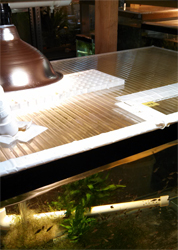 |
|
To
address humidity issues starting in a 100+ tank
fishroom, twin wall polycarbonate
tops were made for all of the tanks. As a result, minor
temperature changes
needed to
be addressed in some tanks, and the alteration of air
exchange at the water surface
caused problems for some more sensitive species. |
 |
|
|
|
The tank
temperature is too warm- Obviously, you want to
unplug any heaters and turn off the lights. With fish that do
not jump,
the tank will cool more quickly with the top
removed. If the overheating had not been for longer than a few
hours, you can gradually
bring down the temperature with cooler water,
doing so gradually, adding up to about 30-40% new water if
necessary. You should be
back to the correct temp within an hour or so. With a
heating that lasted longer than a brief period, you should bring the
temperature down
more slowly. The biggest issue
is the lowering of dissolved oxygen in the water that heating
causes, so if the tank is crowded, it may
be necessary to split up the number of fish,
while increasing the aeration (which will
also bring down the temperature). If caused by a
malfunctioning
heater, the heater must be tossed. See
Heaters for more
information.
The tank temperature is too cold- The problem when a
tank is suddenly chilled is that the fish, provided they
survive, will
have had their immune systems weakened for a period,
and they become vulnerable to opportunistic
infections, diseases,
etc.
following the episode, even if they survive, and
even if the problem is fixed and
temperatures are returned to
normal.
Bring the temperature up slowly, assuming they
all survived the initial chill. Before problems begin, keep a
close eye on their
behavior, and at the first sign of
sickness
(Clamped fins, etc.) do a 25%
water change following the resumption of normal
temperatures. It is also a good idea at this
point to add a half medicinal dose of salt (1/2 tbspn salt to 5
gallons of water) to ease
their acclimation back to normal conditions. If
after a day they are still showing signs of distress (clamped
fins, sluggish behavior)
add the other half dose. Some with
plants sensitive to salt
may not want to do this, or will choose to remove any plants
first. You can
certainly wait to see if problems develop, and
then add salt at that time. The judgement comes down to how long
they were chilled for,
and how weakened they became. With chilling, when
the fish survive, you tend to think the worst is over and all's
good. However,
prepare and expect possible
infections or
problems that may occur over the next several days. Most
chillings occur during a power
outage, or when a
heater has died. If a
heater is the cause due to a malfunction, you must toss and
replace it. |
 |
|
|
| |
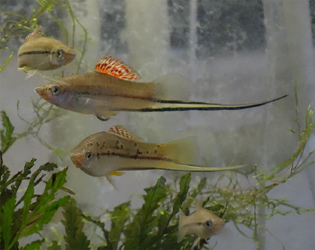 |
|
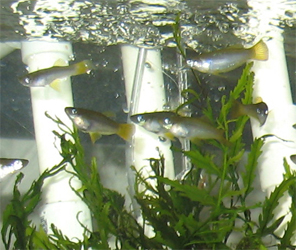 |
|
Ideal
water quality for the fish is a
combination of temperature, aeration,
and established bacteria that stay ahead
of any deteriorating waste.
Water changes
of straight tap should stay below 20% - 30%
per day, but at least 20% per week to
maintain the biological health of your tank.
Live plants and a minimal, easy to clean
substrate creates the healthiest environment,
leading to large, colorful fish that
reproduce
well.
|
 |
|
|
|
Can you change too much water? This is not a simple
answer, as some species respond to heavy changes better than.
others. Most fish kept here do best in a
consistently clean tank with a fair amount of hardscape surface
area for nitrifying bacteria
(we use a minimal amount of 1/4" pea gravel
described here),
live plants and at least
20-50% weekly water changes.
A healthy
tank will then have a dynamic active
nitrogen cycle going on, with
a setup effective at keeping the water clean, clear and the fish
looking and feeling their best. The question
becomes, can I change say, 20% every day? Or, since water
changes are so good
for the fish, and they
grow so large
when doing them, can I change 100% a day (With dechlorinated tap
water?)
Well,
you can put your tanks on a central
filtration system, where aged
water that has been filtered is put into the tanks on a
continuing basis. Photos of discus hatcheries
with rows of bare bottom, pristine tanks are often seen in
magazines, etc., leading
one to believe that fish can be kept in totally
clean, bare bottom tanks.
They cannot.
In those discus
hatcheries, the water is being changed daily - at some places as
much as 100%, but the water being put into the
tanks is aged and filtered so
that it is fully natural and welcomed by the fish. Many
hatcheries run filtered water from local streams
or reservoirs for water
changes after it has been carefully filtered. Tap water,
however, is too clean and stripped of the bacterial
activity that many fish
require to be comfortable. Unless you are running large storage
containers with water being aged for use
as future
water-change water, you
will need to provide an environment that is healthy and more bacteriologically
active than a tank
nearly filled with dechlorinated tap water can provide.
At
Select Aquatics, the fish going out to customer's tanks are
limited to daily
water changes of 15%, and with more fragile or sensitive
species that stay here, and are being bred or worked with, daily
water
changes are limited to 30%.
In other words, it is possible to keep a tank too
clean. As long as you maintain a bacteriologically active
tank with an appropriate
amount of thriving nitrifying bacteria
to maintain even stability in the tank, you can change as much
water as you like, particularly
when already aged and seasoned, and most comfortable for the fish. The addition of the
1/4" pea gravel over 1/3-1/2 of the
bare tank bottom, mentioned
throughout this site for best,
healthy care of these fish, was come to after problems with species
that did not do well in simply bare bottom tanks
with regular water changes. They required greater bacterial
activity in their tanks
to do well. (The Limia
nigrofasciata, in particular). See "Can you Overfilter a
tank?" below.
Can you change too little water? And what's
the deal with Sponge and Undergravel Filters? Or,
didn't
we used to keep tanks without doing
water changes at all? Yes,
but we were in a very different hobby. In the 60s it was enough
to keep a fish alive, and the fish available to
us were from pet stores that were bulletproof from years of the
same lines being
produced in great numbers by the big fish farms.
And with the exception of the livebearers and danios, it was
assumed most
species couldn't be bred in the home aquarium.
Today, only a few species carried by
Select Aquatics can
be found in fish stores, and many are just a few generations
from the
wild. Where nothing but guppies,
swords, platies and occasionally
mollies were all that were
ever bred, everything here can be
bred, and many hobbyists routinely expect to
breed many, if not most of the fish found in today's pet stores.
Most importantly,
most of us now expect to be able to breed these
rare species
that are only a few generations from the wild.
Not doing water changes and using
filtration that
keeps the dirt and mulm within the aquarium is not going to
satisfy these fish,
and will not maintain them at their best color and size,
or so that they will breed.
Today we know the best possible thing you can
do for your fish is to change its water, a
practice that only begins the steps required to breed these fish
successfully.
Some habits from the 60s are still in the hobby, particularly
when the practice is inexpensive, or offers the implied promise
of less work or maintenance. You will see that
throughout the site I do not advocate the use of undergravel or
sponge filters, as
they come from a time when organic material left
to decay in the aquarium was not considered to be a bad thing.
With sponge filters,
they must be removed and cleaned of accumulated
mulm and debris with aged aquarium at least monthly. They also
do not stir up the
aquarium and remove the finer mulm that will
collect, so you will need to go in 2-3x monthly and siphon out
any excess organic matter.
Most aquarists do not do those things, as they
assume the sponge filters require less effort, and you cannot
see how dirty a sponge
filter actually is, when it may in fact be the
equivalent of filter floss that is nearly black with waste.
With these livebearers, often from moving streams
and constantly replenished, fairly clean water, we now know that
sponge type or
gravel
filters that keep the mulm within the aquarium are actually
causing harm. Sponge filters are excellent for raising young
egg
layer
fry that will feed on its
surface, and though various styles of sponge filters will keep
many types of fish alive for long periods,
any sponge type filter should never be used as
the sole source of filtration for a tank where optimum health
and breeding of your
fish are the goals. Some of the species here will
simply not live long in a tank with sponge or undergravel
filters as the sole form
of filtration.
Most hang on the back filters, in the tank
box filters and canister filters
are all excellent, where the collected organic
waste can be removed from the water on a routine
basis.
Most
importantly, fish cannot tell us how they are doing. A fairly
washed out, stunted fish is not OK because it gets up, ready to
eat every morning. Do
water changes and remove
the mulm. Your fish
will thank you for it. Even if they can't say so.
Can you overfilter a tank? No, but
you can create a tank, with all the best of intentions, that is
too clean for some fish, and
they will not survive. And the issue isn't
cleanliness, but the amount of nitrifying bacteria within the
aquarium. An appropriate
amount of nitrifying bacteria within an aquarium
is essential to keep ammonia and nitrate levels stable and
consistently within
healthy ranges. Providing a
bare bottom tank with
robust, non disruptive filtration and a few
plants, even with
long seasoned
water, will not work for some fish. This is why I
provide the single layer of 1/4 inch pea gravel in all of the
tanks here, they can
easily be cleaned of collected
mulm and organic
waste, while also providing surface area for the colonization of
bacteria. The
Limias, particularly the Limia nigrofasciata
require a lightly gravelled tank for this reason.
If a tank
is set up properly, and you are able to keep the disruption of
the tank environment to a healthy degree with whatever
filtration type you are using, you cannot overfilter the water in a tank.
See "Can you change too much water?" above. |
 |
|
|
| |
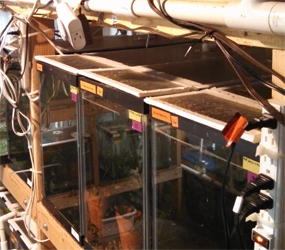 |
|
A
row of tanks in the alcove section of the
fishroom. Though the
PVC automatic
water change system (not seen, but hooked up at the
back of these aquariums) allows for tanks to be
disconnected and
pulled out easily, a leak is never a good thing. Extra
tanks of
each size are stored, so that when a leak does happen,
a tank can
be quickly drained, taken off system and pulled out.
The new tank
is slid in, filled, box filters dropped in, single
layer of gravel
sprinkled on portion of bottom, hooked up to the
water change system
and ready to go. the other tank is then dried out and
repaired. |
 |
|
|
|
The tank is slowly leaking- Tanks do
not explode, or suddenly blow apart, but the occasional story of
something like
that happening is what people remember. As a
rule, most tanks will start with a slow leak, and often it never
becomes more than
that. When this happens you always want to
address it, as it will likely get worse, but generally over a
period of days. Sometimes
an entire seam will split, this is rare, but if
ever a tank empties its water on to the floor, it will be
because a
seam came apart.
I have found this more with older plexiglas
aquariums than with glass, but it can happen to either. The
first seams to split are
usually the bottom. But an entire seam opening up
is very rare. Usually you see dripping coming from the corner of
a tank, and
when that happens make sure it is the tank, and
not a hose or something dripping water from the tank. Then
immediately start to
drain it down, as less water weight reduces the
pressure against wherever the leak is. Move the fish, then drain
the tank and
clean it out. At that point, particularly with a
tank of 40 gallons or less, you might decide to fix the leak
yourself.
See
Repairing a
leaking aquarium.
The tank is half
empty with water on the floor- Immediately fill
buckets with water left in the tank, and get any fish
into the buckets. Be careful not to overcrowd them and
get airstones going into any buckets that you put fish into.
Drain the rest
of the tank and take everything out of it. Focus on
getting the fish settled somewhere else, and don’t think about
the tank.
You can’t work on it till it dries out anyway.
Next day, if it isn’t obvious already, you will need to find out
where the leak
originated. Then check out “How To Repair an
Aquarium.”
|
 |
|
|
| |
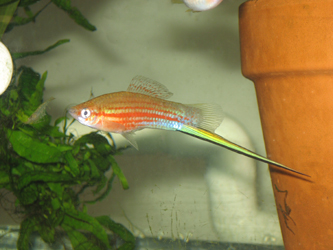 |
|
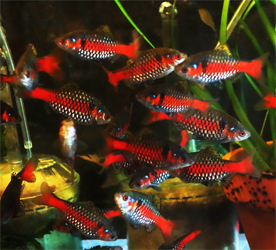 |
|
Adequate light is essential to a healthy
aquarium. Besides making plant growth
possible, light contributes to healthy bacterial
growth, and fish respond to the light used. the
alvarezi blue sheen is
not normally seen unless
the light is correct. The
Odessas require low to
moderate light to feel comfortable, and show
their best color.
|
 |
|
|
|
The light does not work / Do I even need light
over the aquarium? – Many fishrooms will depend on
the room’s
ceiling mounted overhead
lights to provide all
of the light the tanks receive. This can work if the live
plants
provided can survive
under exceptionally low light, or there are no
plants at all, and possibly if there is some type of
filtration
going on beyond the
in-tank filters. (A central sump, for example).
Light going into a tank does many things. It stimulates plant
growth, which oxygenates
and filters the water, and also stimulates
bacterial growth, so that a tank can facilitate a healthy
nitrogen cycle, aiding filtration.
And without
light, you can’t see the fish! Yes, light is important, and
essential to a healthy aquarium.
The light has fallen
in the water- This isn’t the big deal you would think
it is. There will occasionally be times when stray
current could be introduced into your water.
The fish will not be electrocuted, nor will you be injured by
touching the water.
When a live wire finds itself in your aquarium,
simply go to the outlet and unplug it, then
remove it the device from the aquarium.
I can't
afford this stuff - is there another way? - Tanks and
equipment are available routinely at often a small fraction
of the retail price at local aquarium club
meetings. Look for local aquarium clubs in your area to obtain
fish you may never see
in a pet store, as well as used equipment offered
so other hobbyists will use it. If you do not have a local club
nearby, consider
starting one - putting up notices at pet stores
looking to grow the local hobby. Most clubs are just a small
group that trade fish
amongst themselves, building up a treasury,
auctioning off their fish to one another at each monthly
meeting. Many clubs will
rotate where meetings are held, so that the club
gets to see a different fishroom each month. Think about it! And
though most
clubs are for all types of fishkeepers, you can
certainly focus on one type - such as livebearers, killies,
cichlids or bettas.
|
 |
|
|
| |
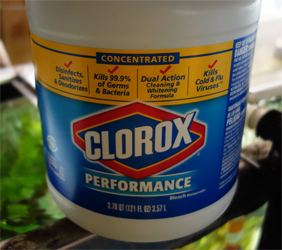 |
|
Good 'ol bleach. Any unscented bleach should do, just do not
get "splashless" as thickeners have been added, and
they will
foam up when put into an aquarium with aeration,
causing quite
the mess when bleaching a tank! |
 |
|
|
|
How to Bleach / Chlorox/ Disinfect a tank
This is a complete,
radical solution to remove any pathogens from an aquarium. This process
is used here routinely following
a disease outbreak from a viral or bacterial
cause, particularly when the disease outbreak was not fully resolved, or
when the
infection caused a loss of all of or
the majority of the fish in the tank. There are two ways to do this, the
first is the only option
if you are dealing with external canister
filters, wet/dry systems, etc. But if you are just doing a tank and some
minor equipment,
#2 is much quicker, and with less work.
#1
1- Remove and destroy all of the remaining fish
from the tank. Leave any plants, gravel filtration, etc. in the tank as
the
previous disease can be spread by anything
from that tank coming into contact with another aquarium.
2- Obtain bleach – Here, we use Chlorox, but when
purchasing, avoid any products listed as “splashless”. When that is the
case, thickeners have been added to prevent
splashing. The tank will be running during this procedure, and
splashless products
will foam up and overflow from the aquarium.
Plain, unscented bleach.
3- Do not treat a tank this way in a non
ventilated or closed room, particularly when other healthy tanks are
present.
The chlorine released into the air could cause
problems with other aquariums nearby, but a fan and open windows
or ventilation
will work fine
4- Add 1 cup of bleach per every 10 gallons of
water into the aquarium. A 50 gallon aquarium would then receive 5 cups of
bleach.
Stir up the gravel and make sure that all areas
of the tank are exposed to the bleached water. After the bleach is
added, fill
the tank to the very top. Let the tank run
normally - filters, etc. for 24 hours. This will also destroy all
bacterial activity in any wet/dry
and trickle filters.
5- After 24 hours, remove any broken down plant
material, then drain and refill the tank with clean water. Let
the tank run for 24
hours. Do this 2 more times, each draining and refilling
separated by 24 hours. At this time remove any filter medium from the
filters
and replace with clean medium. The tank is
drained and refilled 3 times over 3 days. I have simply found that three
times seems to
be required, stir up any substrate thoroughly
each time.
6- At the fourth refill, make sure the water is dechlorinated and add test fish that are not your most valued
fish, and see if the fish
survives for 48 hours.
7- If the fish does well, add seasoned aquarium
water from a nearby healthy aquarium, and prepare the tank for fish as
you would
any newly set up aquarium, and add fish as
normal.
#2
1- Remove and destroy all of the remaining
fish from the tank. Leave any plants, gravel filtration, etc. in
the tank as the
previous disease can be spread by anything from
that tank coming into contact with another aquarium.
2-
Obtain bleach – Here, we use Chlorox, but when purchasing, avoid
any products listed as “splashless”. When that is the
case, thickeners have been added to prevent
splashing. The tank will be running during this procedure, and
splashless products
will foam up and overflow from the aquarium.
Plain, unscented bleach.
3- Do not treat a tank this way in a non
ventilated or closed room, particularly when other healthy tanks are
present.
The chlorine released into the air could cause
problems with other aquariums nearby, but a fan and open windows
or ventilation
will work fine.
4- Add 1 cup of bleach per every 10 gallons of
water into the aquarium. A 50 gallon aquarium would then receive
5 cups of bleach.
Stir up the gravel and make sure that all areas
of the tank are exposed to the bleached water. After the bleach
is added, fill
the tank to the very top. Let the tank run
normally - filters, etc. for 24 hours. This will also destroy
all bacterial activity
in any wet/dry and trickle filters.
5- Remove any broken down plant material and
totally empty tank. Clean out tank thoroughly and dry with a
towel, and let tank then
dry out completely for 24 hours.
6- Refill and set up the tank as new, and add
test fish that are not your most valued fish, and see if the
fish survives for 48 hours.
7- If the fish does well, prepare the tank for
fish as you would any newly set up aquarium, and add fish as
normal.
|
 |
|
|
| |
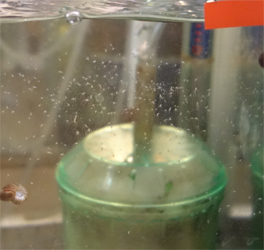 |
|
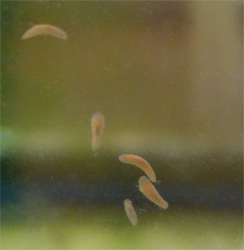 |
|
At
far left is a colony of the many
tentacled hydra, and though small,
they can still snag a fry. Near left
is one of many flatworm species that
can infest the aquarium. Most fish don't
eat either of these, and getting rid of
them without using chemicals is difficult. |
 |
|
|
|
Unwelcome guests
There are
worms on the glass inside the tank- A number of
organisms can take up residence within
an aquarium, and few are of any real concern
regarding the health of the fish. They are generally unpleasant
to look
at, and those most noticed are often not eaten by
the fish we keep (or they wouldn't be a problem!). The most
common are flatworms/ planaria, and they can be
difficult to eradicate.
The best solution is the most natural - find
something that eats them, whatever they are. Two species are often
used
to get rid of unwanted organisms, the blue
gourami and various species of botia - who are the best at
getting rid
of the smaller snails we often encounter. Many
species of Cichlid will eat shrimps, grammarus, and other
smaller
organisms that can come into a tank. But that
solution is often hit or miss, and you will end up with fish bought
just
to eradicate the pest.
The second solution is to remove them by hand by
simply wiping down the inside of the aquarium and removing the
worms or organisms as you see them. This will
generally keep them in check, but rarely gets rid of them
permanently.
However, with species of fish sensitive to
chemicals or foreign substances added to their water, it is the
method
generally used here.
The third solution is chemical, by adding a
product formulated specifically to get rid of the organism.
Various
remedies to get rid of planaria, for example, are
available. Smaller organisms can often be eradicated by using
the dewormer/ antiparasitic
Levamisole
hydrochloride, but I have found that full sized planaria can be
beaten
back, but rarely entirely removed using
Levamisole at its normal dosage. It will likely work at greater
concentartions, but I do not wish to expose the
fish here to higher concentrations. With a little research, you
can generally find products available online to eradicate various pests.
There is a 4th way, and before using it, it would
be best to do some research first. If your fish can handle
higher temperatures, some organisms can be killed
by raising the tank temperature to 84-85 degrees. I would
not attempt that unless I knew it was a species
that will respond to that treatment. The shrimp here, for
example, can be eradicated that way.
There are hydra in the tank
- These appear occasionally, and are the result of a food used
that is attractive to
them. Routinely feeding newly hatched
brine shrimp
often results in hydra appearing in a tank. When hydra appear
here,
they are easily eradicated by simply not feeding them
the food that caused them to appear for a few days. Various
other
chemical methods are available, but by simply
switching the foods going into a tank for a few days, they can
often be
kept under control. It is important to address
them as they are first seen, as they will eat foods as large as
guppy fry.
There are little jumping critters on the water surface-
Occasionally small flies, gnats and other fauna will
find their way into your aquarium. Other than dragon fly
larvae that will eat small fish, hydra that may eat fry, or
mosquito
larvae that may turn into mosquitos and bite us,
introduced creatures are generally unsightly at worst, and an
extra
couple feedings for the fish at best. There is no
magic to the accepted live foods we generally keep. Any small
creature
the fish will eat is generally a positive, and when
it isn't good for them, they won't eat it.
As to the
little flies, I have found they are a seasonal, temporary result
of humidity changes and possibly excess food
being present. Increasing the ventilation over
the water surface and cleaning up conditions will usually cause
them to
disappear over a few days.
So...
How you set up your tank will determine how much work will be
needed, how well your fish will do, whether they will breed,
and whether the young that are born will survive.
The tank you keep must best
fit your needs and time available or the
fish will suffer, and the tank will
not be successful over the long term. Going home and setting up
your tank just as you
saw the tanks at the pet store is not always a
good idea. They set up their tanks to look good so
people will buy fish
kept in the store for short periods, fish that
are never bred. You want to set up your tank at home so the fish
will live live
long, happy and reproductive lives. The
information here assists you toward a tank that is affordable, easy to understand,
and ideal for your fish and their fry.
Hopefully the information provided here will
better paint a picture of your options and how best to move
forward, so that
you are thinking of the fish first, and
what is best for them. If you have further questions or
concerns, please do not
hesitate to drop me an email, and I respond
to customer emails in the early morning, 7 days a week. Thank
you!
Greg Sage
selectaquatics.com
selectaquatics@gmail.com
|
 |
|
|
|
|
|
|
|
|
|
|
|
|
|
|
|
|
|
|
|
|
|
|
|
|
|
|
|
|
|
|














